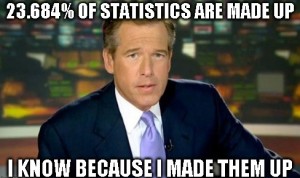
Data Shows that DUI Cases can be Beat
Can I Beat this DUI Charge?
That is a very typical question for dui defense attorneys. Most potential clients feel that it is impossible to win a DUI case. Statistics say otherwise. Your chances of winning your DUI case depend exclusively on the facts and circumstances surrounding your arrest. However, some counties seem to be a bit for defense friendly than others. The way I typically approach the situation is to tell the potential client my honest opinion based on the information that has been provided by the client. Keep in mind that sometimes the information provided by a client is not the most accurate. It is simply human nature to try to present your case in a fashion that makes you look the best. I’ve never cited to conviction statistics in a client meeting because I did not know the exact figures. I probably still won’t after today because it can set unrealistic expectations.
What do the statistics say?
The statistics actually paint a pretty rosey picture for a DUI defendant in Broward County, Florida. The Florida Department of Highway Safety and Motor Vehicles keeps records on how many DUI citations were issued in a county and keeps records on how those DUI citations were resolved in court. Much to my surprise, there were significant statistical differences in counties throughout the state. So while your odds might be pretty good in Fort Lauderdale, they might not be as good in Ocala. Visit the FLHSMV Uniform Traffic Citation Report to see the reports for the entire State of Florida.
Please keep the following in mind while reviewing the statistics:
- There will be a certain number of DUI charges that are unresolved at the end of each year due to continuances and the date of the offense;
- The data below is from year 2013 in order to allow additional time for cases to be resolved and reflected in the annual data;
- The data is limited to three counties. Broward County, Miami-Dade County and Marion County;
- The term “guilty” does not mean guilty of DUI;
- “Guilty” as used below means a finding of guilt as to DUI, another traffic criminal matter charged with the DUI or a reduced charge from the DUI;
- For example, if an individual is charged with DUI and he or she takes a plea to reckless driving, that still counts as a guilty. This inflates the amount of individuals who are found “guilty” without disclosing how often the state reduces the charge.
Broward County DUI Arrest Data 2013
TOTAL ARRESTS: 3974
TOTAL PENDING DISPOSITION: 581
TOTAL DISPOSSED: 3393
TOTAL GUILTY: 1885 (56%)
TOTAL NOT GUILTY: 48 (1%)
ADJUDICATION WITHHELD BY JUDGE: 131 (4%)
TOTAL DISMISS OR NOLLE PROS: 1328 (39%)
Palm Beach County DUI Arrest Data 2013
TOTAL ARRESTS: 3034
TOTAL PENDING DISPOSITION: 969
TOTAL DISPOSSED: 2065
TOTAL GUILTY: 1343 (65%)
TOTAL NOT GUILTY: 31 (2)
ADJUDICATION WITHHELD BY JUDGE: 5 (<1%)
TOTAL DISMISS OR NOLLE PROS: 684 (33%)
Marion County DUI Arrest Data 2013
TOTAL ARRESTS: 915
TOTAL PENDING DISPOSITION: 31
TOTAL DISPOSSED: 884
TOTAL GUILTY: 737 (83%)
TOTAL NOT GUILTY: 10 (1%)
ADJUDICATION WITHHELD BY JUDGE: 6 (1%)
TOTAL DISMISS OR NOLLE PROS: 131 (15%)
Statistical Interpretation
The Florida Department of Highway Safety and Motor Vehicles has this information readily available for the years 2011 through 2014. Over the course of those four years, the annual arrest total by county varies, but not significantly. However, the percentages remain very close to the same in all categories.
Why?
Why does Marion County, Florida have an 83% conviction rate? Why does Broward County, Florida show a conviction rate of 56%? There are several plausible explanations for the variations between counties. Are conviction rates higher in smaller, more conservative, rural areas due to the composition of the jury pool? Are larger counties precluded from devoting substantial resources towards DUI enforcement due to other prosecutorial priorities? The statistics don’t tell us why.
All that we know, based on statistical data alone, is that Broward County has a 56% conviction rate and that includes all of the convictions for lesser offenses such as reckless driving. Marion County has an 83% conviction rate. The statistics above clearly show that DUI’s can be beat and criminal defense attorneys are winning DUI cases on a regular basis. Hiring a criminal attorney with substantial DUI experience can have an enormous impact in the outcome of your case. Make no mistake about it, the odds are still stacked against you, but a good DUI attorney, you can level the playing field.
For more information, please contact us at:
The Law Offices of Michael A. Dye, PA, 1 East Broward Boulevard #700, Fort Lauderdale, FL 33301 (954)990-0525 or
The Law Offices of Michael A. Dye, PA, 2 S Biscayne Blvd, Miami, FL 33131 (305)459-3286





